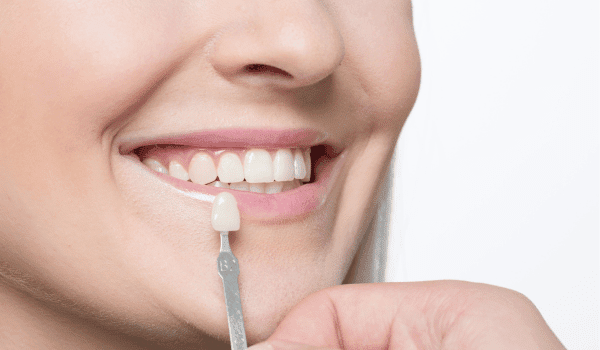When looking into dental procedures to restore your teeth, many people end up comparing porcelain crowns vs veneers as they seem very similar. However, they’re actually quite different. To help you decide whether crowns vs veneers are the right dental procedure for you, we’ll discuss their similarities and differences, when each method should be used, and more.
What are the Similarities Between Crowns vs Veneers?
Both dental crowns and porcelain veneers are dental procedures used to restore teeth that have been damaged, are crooked, or are discolored. When choosing a porcelain crown (over a metal crown), both crowns and veneers allow you to correct your teeth while still giving you the look of a natural smile.
An important similarity in these dental procedures is how you take care of your crowns vs veneers – brush your teeth twice a day, floss daily, and attend regular appointments with your dentist for a professional cleaning. But you’re not here to learn about every single similarity in a crown vs veneer, so let’s get into what their differences are.
What are the Main Differences Between Crowns vs Veneers?
While both porcelain crowns and veneers give you a whiter, straighter smile, crowns are considered a restorative procedure while veneers are considered a cosmetic procedure. Crowns are used when your teeth have significant damage or when large filing of your teeth is not appropriate.
Another difference between veneers and crowns to be aware of when comparing crowns vs veneers is how they’re placed and how they fit your tooth. With many dental crowns, your dentist shapes your tooth, takes impressions, and places a temporary crown. Once your crown has been made, which usually takes a few weeks, you return to the office to have your permanent crown placed.
There is also the option of choosing same day crowns – which skip the temporary crown as your permanent crown is made in-office while you wait. Whether you decide on a traditional crown or a same day crown, your crown will cover your entire tooth and can be used to correct aesthetic and functional dental issues.
There are three different types of veneers, but the most common type are porcelain veneers, which are used to conceal cracks, chips, stains, and other aesthetic dental concerns. To fit your veneers properly, your dentist will grind your teeth down, though no nerves or roots are damaged. Once enough enamel has been removed, an impression of your teeth are taken to make your custom veneers. Once your veneers are ready, you’ll return to the office to have them fitted over the front surface of your teeth and cemented into place.
Following the placement of a dental crown, you may notice inflammation, sensitivity, or irritation. While the worst of these effects subside in the few days following your procedure, it may take up to two weeks before you notice the effects have completely subsided. The most common side effect reported after getting veneers is tooth sensitivity, which can take up to two weeks to subside.
What Lasts Longer, a Crown or a Veneer?
Although porcelain veneers are permanent, the typical lifespan of veneers is around 15 years. Because your natural teeth are filed down to prepare for veneers, your veneers will need to be replaced when they’ve reached the end of their lifespan. Similar to porcelain veneers, dental crowns have a typical lifespan of around 15 years.
To prolong the life of your veneers or dental crown, maintain good oral hygiene by brushing and flossing regularly and attending regular dentist appointments. It’s also important to avoid damaging your teeth, whether by biting hard surfaces (such as opening packages with your teeth) or eating extremely hard foods.
Do Crowns Look More Natural Than Veneers?
There are 6 common types of dental crowns, and the type of material used to create your crown will determine how natural it looks. Ceramic and porcelain crowns, including same day crowns, are the most common crowns recommended by dentists when patients are opting for a more natural look.
Porcelain veneers are one way to create a perfect, yet natural looking smile. When placed properly by a skilled dentist, your veneers will complement your complexion and bone structure, making your smile appear more natural.
Whether you’re leaning toward a crown or veneers, your dentist can create a more seamless look by whitening your natural teeth before the crown or veneers are placed.
How Do I Know Whether I Need a Dental Crown or Veneer?
Your dentist will help you decide whether crowns vs veneers are the better option for you. Crowns are often recommended over veneers when your enamel is compromised. Your enamel can be compromised from many things, including damage to the tooth, a large filling, or a root canal. Veneers are more likely to be recommended if your only concern is improving the appearance of your smile.
If you’re still debating crowns vs veneers, our dental experts can conduct an exam and provide recommendations. With four offices located across South Florida in West Palm Beach, Boca Raton, and Fort Pierce, our husband and wife dental team, along with our team of dental practitioners and specialists, provide expert dental care at your convenience. Contact us today to schedule an appointment or learn more about our family dental services guaranteed to make you smile.




